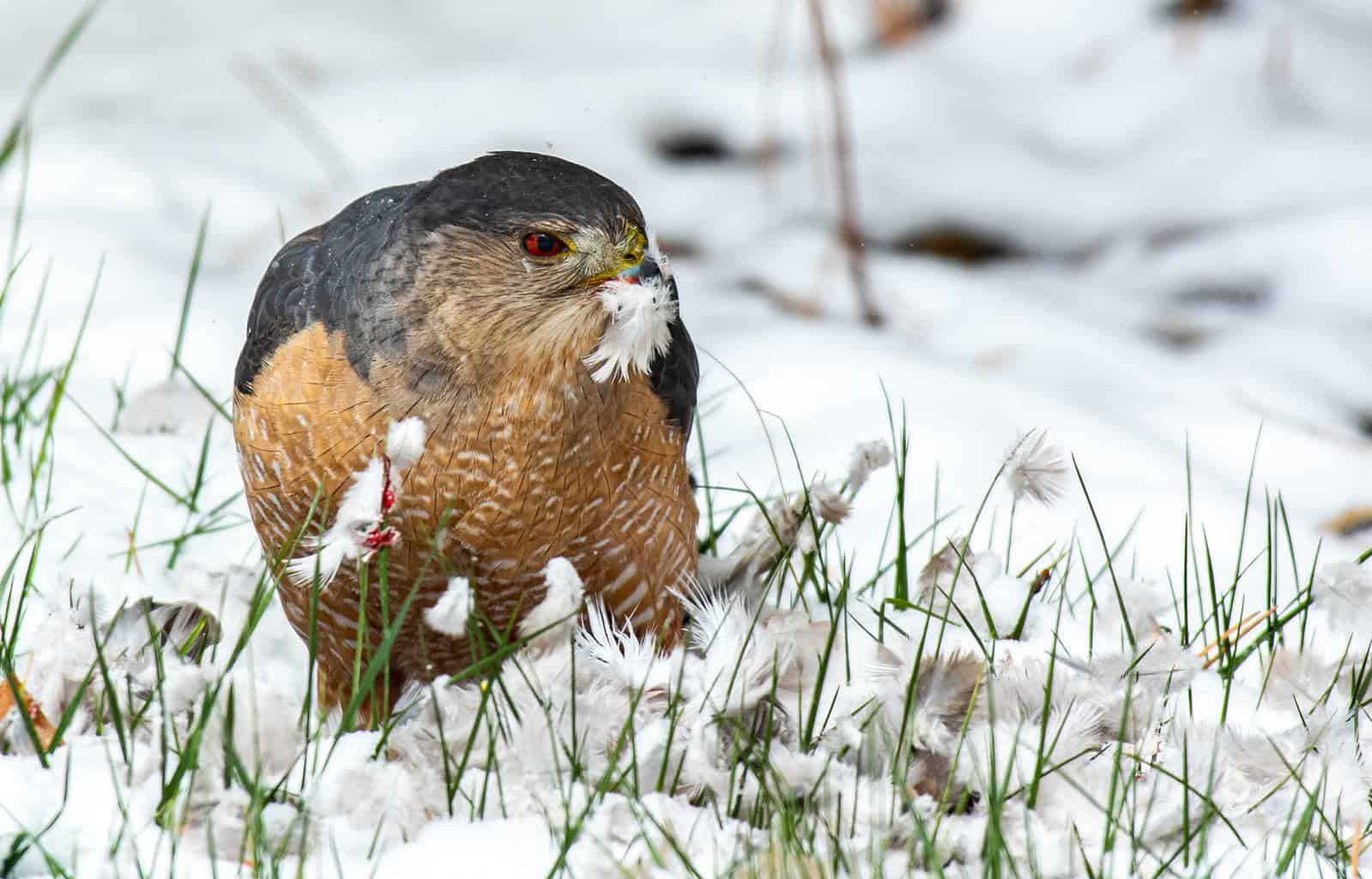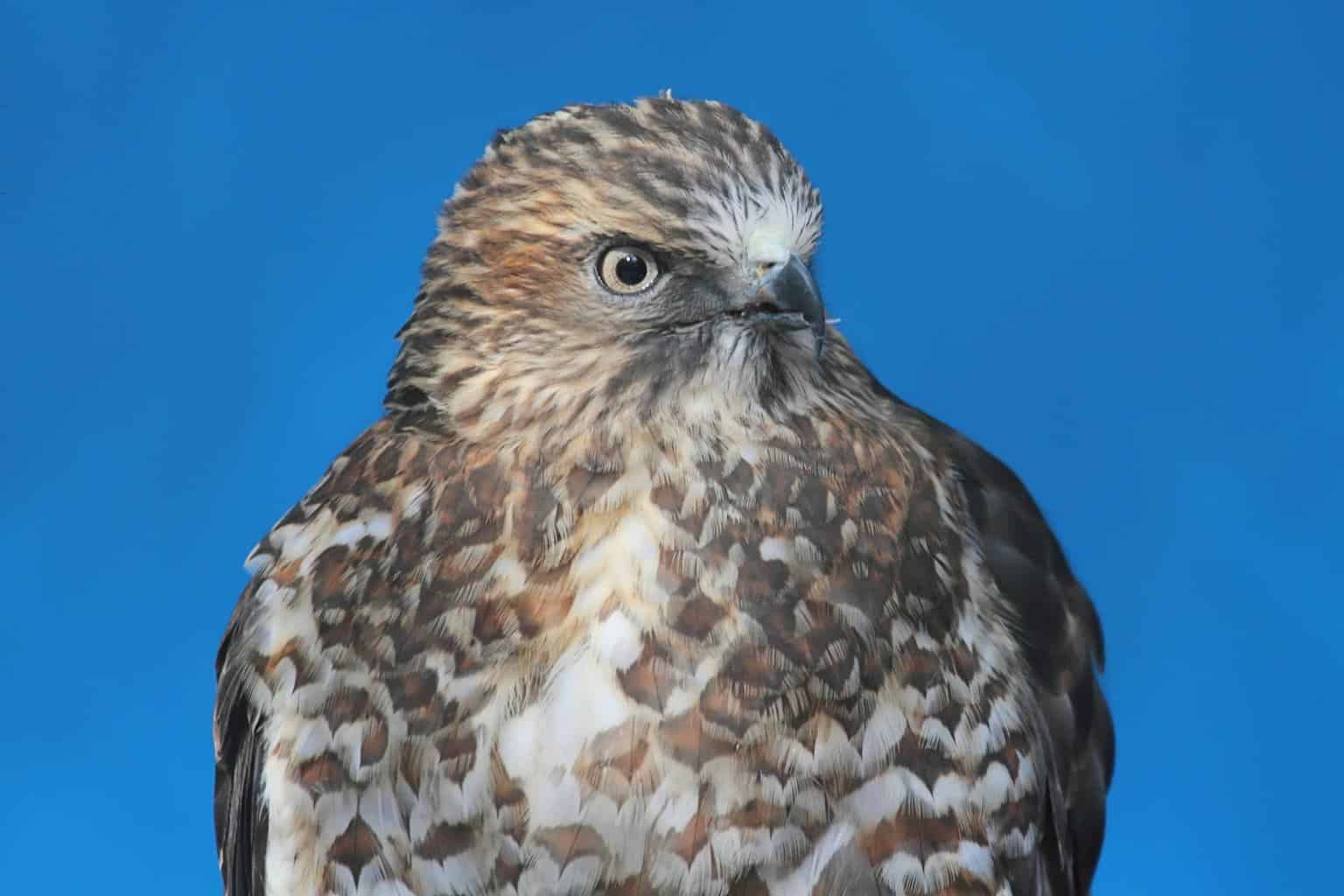Thanks to its beautiful landscapes and dazzling waterfalls, Vermont has become a top tourist destination. The 45th state is home to many attractions including Lake Champlain, Shelburne Museum, Hildene, and the wonderful Church Street Marketplace.
Whether you’re there for a quick trip or extended visit, be sure to make time to explore the state’s wildlife. There are plenty of interesting animals to observe, including long-tailed weasels, minks, gray squirrels, and American martens, that you may not see anywhere else.
Also housed in Vermont is an array of birds of prey, and of these, hawks are the most characteristic. It’s impossible to visit the state without a hawk or two grabbing your attention! For this reason, we’ve compiled a list of the seven hawk species you’ll see here, plus all the information you’ll need to know to identify them.
What the “hawk” are you waiting for? Pack your bags, grab your binoculars, and let’s go birdwatching!
Sharp-Shinned Hawk

- Scientific Name: Accipiter striatus
- Length: 9.4 – 13.4 inches
- Weight: 3.1 – 7.7 ounces
- Wingspan: 16.9 – 22.1 inches
Also referred to as sharpies, the sharp-shinned species of hawks are permanent residents in the majority of Vermont. Sharp-shinned hawks tend to have short, round wings and long tails, just like most accipiters, of which they’re the smallest.
Sharp-shinned hawks are known for their sneaky hunting strategies. They perch inside foliage waiting for potential prey to appear, or they creep up on their victims and swiftly capture it with their sharp talons. These birds love to eat frogs, lizards, insects, and other small mammals and birds.
These raptors are usually found in forest canopies during their breeding season and perched on coniferous trees when it nests. Unfortunately, due to loss of habitat, this species’ population is gradually declining.
Northern Goshawk

- Scientific Name: Accipiter gentilis
- Length: 20.9 – 25.2 inches
- Weight: 22.3 – 48.1 ounces
- Wingspan: 40.5 – 46.1 inches
The Latin meaning of gentilis is “noble,” which is fitting as only nobility was allowed to fly goshawks during the Middle Ages. Northern goshawks are medium-large birds in size with broad wings and a long tail. Some goshawks are brown while others are grey-black.
This species is usually found in coniferous and deciduous wooded forests, and although their hunting styles show significant variance, they’re generally well-known for their powerful and rapid pursuits. They fly swiftly, occasionally twisting around a branch or crashing into another, hoping to catch prey. Their victims include small rodents, snakes, insects, squirrels, rabbits, snowshoe hares, and other medium-sized birds, like crows and grouse.
These hawks are known to be highly territorial. They fly alone or in pairs, and defend their territory from others of their own sexes. Territorial fights may even escalate to physical brawls, resulting in death.
Red-Shouldered Hawk

- Scientific Name: Buteo lineatus
- Length: 16.9 – 24.0 inches
- Weight: 17.1 – 27.3 ounces
- Wingspan: 37.0 – 43.7 inches
Red-shouldered hawks are medium-sized species with rounded wings that spread out and forward during flight. They glide and soar with their wings in a characteristic reaching position. Adult hawks have reddish-brown breasts with horizontal streaking, and their tails are white with thick black stripes.
They also release a very distinctive “kee-yah” screech. If you ever hear this sound, it’s definitely the red-shouldered hunters! These raptors are considered a migratory species, but they prefer dense woodlands, woods around streams or rivers, and swampy lowlands. In the winter, they’re seen more frequently in the open. They hunt small mammals, lizards, snakes, frogs, toads, fish, insects, crustaceans, and other small birds; they scout out their meals by perching or flying.
The development of land by humans and the use of pesticides resulted in the loss of suitable habitat for these raptors. This explains the long-term decline of red-shouldered hawks.
Cooper’s Hawk

- Scientific Name: Accipiter cooperii
- Length: 14.6 – 15.3 inches (males), 16.5-17.7 inches (females)
- Weight: 7.8 – 14.5 ounces (males), 11.6-24.0 ounces (females)
- Wingspan: 24.4 – 35.4 inches (males), 29.5-35.4 inches (females)
Cooper’s hawks are iridescent black with long, wedge-shaped tails. Their long bushy neck feathers are brownish-grey and distinctively puff out when they call, and birds of this species are year-round Vermont residents.
These hawks are skilled hunters, using their nimble feet to grip prey and squeeze it to death. They’ve even been reported to drown their victims before eating them. Their main food consists of other birds and small mammals including chipmunks, squirrels, mice, and bats. Sometimes, they’ll even eat insects and reptiles.
Although their choice of habitats makes them hard to spot, Cooper’s hawks can be noticed in secluded woodlands, suburbs, and forests during their soar period daily. Unfortunately, many of these hawks suffer fractured chest bones that are usually identified post-mortem. That’s nothing to worry about, though, as these injuries are common and heal safely.
Rough-Legged Hawk

- Scientific Name: Buteo lagopus
- Length: 18 – 24 inches
- Weight: 24 – 51.2 ounces
- Wingspan: 47 – 54 inches
As indicated by their name, lagopus means “hare-footed,” which references the diverging feathers on birds of this species’ legs, making them look “rough”. Rough-legged hawks have a notable presence in Vermont and the majority of the United States. Only during its breeding season does it migrate further north; its furry legs keep the bird warm as it breeds in chilly, arctic temperatures.
Though they vary in color, rough-legged hawks characteristically have a dark band across their chests and a white band at the base of their tails. Their small beaks and feet help them adapt to arctic climates.
Rough-legged hawks usually hunt from the air during flight, and upon noticing a small mammal (which makes up 90 percent of their diet), like rodents, mice, and lemmings, or other bird species, they dive down and capture their prey. Due to its hover-hunt style, this species prefers more open, treeless areas. They may also be seen in shrub-steppes, river deltas, marshlands, agricultural fields, and grasslands.
Red-Tailed Hawk

- Scientific Name: Buteo jamaicensis
- Length: 9 – 13 inches (males), 19.7-25.6 inches (females)
- Weight: 3 – 8 ounces (males), 31.8-51.5 ounces (females)
- Wingspan: 20 – 26 inches (males), 19.7-25.6 inches (females)
Red-tailed hawks are the most common species of hawks found in North America. Indicative by their name, they have signature brownish-red tails with a pale “V” on their seemingly dark back. It’s also important to mention that partial albinos are common in this species.
They have a raspy, loud shriek that makes them the most recognizable hawks in Vermont — in fact, it’s the cry Hollywood uses any time a hawk or eagle appears in a movie or television show!
Red-tailed hawks usually hunt from a high perch with a clear view, but they’ll occasionally work together to watch different sides of a tree. For this reason, this species of raptors are usually located in open or wooded areas, preferably those with tall trees. They mainly consume rodents, squirrels, rabbits, chipmunks, rats, mice, moles, and weasels, but from time to time, they may eat insects, snakes, or other birds.
Broad-Winged Hawk

- Scientific Name: Buteo platypterus
- Length: 13.3 – 17.3 inches
- Weight: 9.3 – 19.8 ounces
- Wingspan: 31.9 – 39.4 inches
The broad-winged hawk species has narrow rufous breasts with dark brown backs, and their wings are short, pointy, and often confused with peregrine falcon wings. And interestingly enough, these birds of prey have a mallard stripe that gives the appearance of a mustache.
The broad-winged species is indeed a Vermont resident, but they head to South America during the winter months. They’re much easier to spot during the migration period since they travel in large groups called kettles for over 4,300 miles.
Broad-winged birds are a species of still-hunters, who scout out their prey from perches and edges of openings. You’ll find them feeding on birds, small mammals, lizards, frogs, and invertebrates. Although they nest near water, they mainly prefer living in unbroken woodlands.
Wrapping Up
Hawks, whether in Vermont or anywhere else, are quite similar in terms of appearance, hunting, habitat, and nesting. It might be challenging to tell them apart unless it’s right in your grasp. For this reason, you should try to remember one defining feature about the hawks you think you’ll see — good thing we gave you a few to choose from!
Keep in mind that the hawks mentioned are those that take Vermont for a home. However, during migration season, many other hawk species may briefly appear. Note that hawks primarily migrate from March through May, and from September through November.
Apart from the hawks, the Great Mountain State is also recognized for a variety of breath-taking birds, including species like the hermit thrush and the northern flicker.
On another note, hawks usually won’t come after you. That’s good news! Patrick Comins, executive director of the Connecticut Audubon Society has mentioned that “It’s fairly unusual for hawks to cause any injury to people,” however, their typical parental instinct makes them attack anyone threatening their nest, so if you come across one, keep your distance.
If you find yourself in Vermont, be sure to keep your eyes open for these powerful hunters! How many species can you find?

